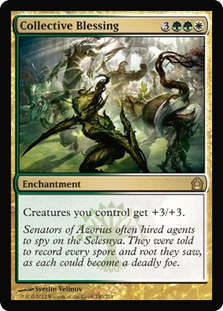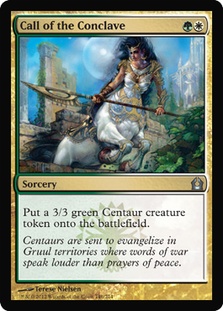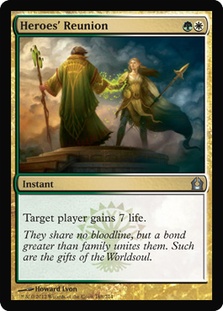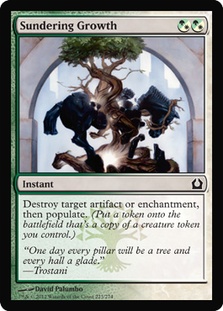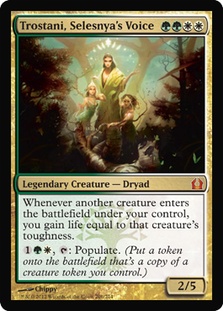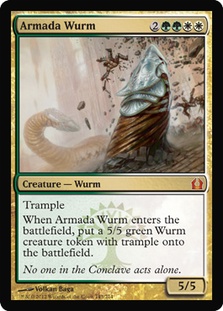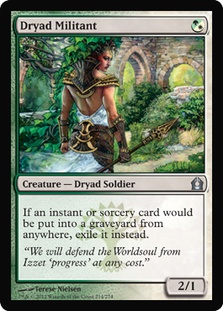What are the Top 10 Selesnya cards in Return to Ravnica? Where (if somewhere) might a particular card shine? Is there, perhaps, a brew to be found? These are the questions we seek to answer in this week’s Flores Friday!
10. Collective Blessing
You set an arbitrary cut-off point. That point is ten cards. You peruse the list of available Selesnya cards. One of them is weakest (while still ostensibly being in a Top 10). That card is Collective Blessing.
I will be the first one to admit that I am not great at assessing mass pump spells that cost more than two or three mana. In the era of B/W Tokens, when LSV was shining in Standard with cards like Ajani Goldmane and G/W Tokens was rising up to meet B/W as one of the strongest decks in Standard (again with Ajani), I kept wanting to cut the planeswalker when in fact it was the best planeswalker in Standard for a fair stretch. And Overrun? Even for free off a Windbrisk Heights? All that does is kill the opponent real quick!
So I was initially quite down on Collective Blessing. As I said, I am not the cheeriest assessor in terms of expensive pump spells, and this one is even more expensive than Overrun, albeit potentially more powerful (same pump but persistent rather than lasting only the turn).
Brian David-Marshall was actually the Magician that brought me around on this card. “Isn’t it possible,” he asked, “that you are in a tokens mirror. Your opponent is making 1/1 Saprolings; you are making 1/1 Saprolings. Populate is a thing, so maybe there are more powerful tokens than just a 1/1. There may in fact be a Trostani, Selesnya’s Voice going somewhere… No one can really attack without great sacrifice. And then you draw Collective Blessing.“
So even here, Collective Blessing is a bit of a corner case. It is big and powerful but probably not a four-of. You play it as a one-of or two-of and side it in in order to get an advantage in a mirror that you expect to go some time. The implication is that you will have time to play (and find) a not-populous six because the outcome of the game is not going to be decided quickly. You might be able to develop, but your opponent going to develop and stall you at about the same size and speed (or vice versa). Collective Blessing is your breaker.
And really?
Once down?
Can you not imagine this being an enormous breaker? Literally enormous?
9. Call of the Conclave
It is interesting to see how the game has evolved in just a few short years, Ravnica to Return to Ravnica. When Ravnica: City of Guilds was first spoiled, the game’s foremost deck designer told us that Watchwolf spoke for itself. It was so good that you would need a compelling reason not to play it if you were in colors.
Flash forward over the ensuing years and Watchwolf has turned out not that good. There is nothing wrong with it… It just happens to be a somewhat undercosted guy, and, in fact, more powerful two-drops have been printed in the ensuing years.
Call of the Conclave is, well, basically Watchwolf plus. On its face the card is Watchwolf, only as a sorcery rather than a creature. For most intents and purposes, it is a Watchwolf (an appropriately-positioned beatdown deck can play one on turn two and in theory be very happy with the return), but here you get some bonus synergies. For example, in a Bant deck you can get double duty out of it with the help of Snapcaster Mage.
In terms of pure Selesnya, you can also lean on Call of the Conclave as an early populate catalyst. It can be your initial go-to, allowing you to do some kind of token reproduction shenanigans starting turn 3.
Creatures (3)
Planeswalkers (2)
Lands (27)
Spells (28)

The shell is not dissimilar to Alexander Hayne’s miraculous Pro Tour Avacyn Restored deck, but with green ramp substituting for the blue half. Playing the slowdown role of Feeling of Dread are token setup twos Selesnya Charm and of course card at hand Call of the Conclave (though if you really wanted to it would be pretty easy to sideboard an Island, add one Hallowed Fountain, and devote five total sideboard slots to actual Feeling of Dread).
Initially I had only one Overgrown Tomb for the flashback on Lingering Souls, but Sorin, Lord of Innistrad plays almost blatantly well in this shell. Did we all collectively just forget about the card Intangible Virtue? Is Farseek into Intangible Virtue + Call of the Conclave (into Thragtusk threatening to leave behind a 4/4) not a thing?
If Intangible Virtue proves a thing, you will want to shift sideboards in favor of Ray of Revelation, of course.
8. Heroes’ Reunion
I actually played the card Heroes’ Reunion…in Extended!
And it was actually pretty awesome!
Heroes’ Reunion probably seems like an odd card to be slotted higher than Call of the Conclave, but hear me out: Call of the Conclave is Watchwolf plus. It can be good, but you need a pretty good reason to build a deck around it. Heroes’ Reunion is in a not dissimilar spot, but it has broader applications depending on what you need.
For example, say there is a combo deck that can consistently do 20 damage but has a hard time doing, say, 21. An instant speed card that puts you not only out of kill range but out of incidentals range (dual land issues, sundry “clean up the last point or two” cards the opponent might have) is desirable. Say you are in a format where burn to the face is a thing. Seven life for only two mana is almost assuredly more efficient than whatever the opponent is going to bring to bear at four-for-three mana or wherever.
Viability here is almost certainly as a sideboard card and highly contextual. But when the context is right? Watch out, red mage.
7. Sundering Growth
As above.
Sundering Growth is basically Disenchant or Naturalize for the really dedicated green, white, or green-white mage. Both Disenchant and Naturalize have been played up to and including Pro Tour champion levels, so there shouldn’t be a huge question mark in terms of overall power or appropriateness… More along the lines of where rather than if.
Can that “where” include maindeck?
Honestly… It’s going to depend a lot on what opposing threats are out there. I can certainly imagine a metagame where Intangible Virtue is an important thing so you might want this functionality. It’s obviously great against Oblivion Ring as well. But do you want the potential ups of a Sundering Growth or the consistent, dominating, card advantage of a Ray of Revelation? I would err in favor of Ray of Revelation if I knew the shape of the metagame; the upcoming format is going to have a shortage on playable artifacts: Runechanter’s Pike and Witchbane Orb from Innistrad Block, a couple of Keyrunes (maybe), and from M13 Staff of Nin (?)… Oh yeah, and Trading Post. Looks like Sundering Growth might just have a job to do over Ray of Revelation.
Creatures (28)
- 4 Elvish Visionary
- 4 Borderland Ranger
- 4 Arbor Elf
- 4 Avacyn's Pilgrim
- 4 Geist-Honored Monk
- 4 Restoration Angel
- 4 Thragtusk
Planeswalkers (4)
Lands (25)
Spells (3)

Selesnya Charm is actually the most excitingly costed of the Charms in Return to Ravnica. I don’t know that it is the “best” of the Charms (I would give that title to Izzet Charm), but unlike Izzet Charm, where you overpay by one mana for any of two to three desirable effects, you more-or-less break even on each of Selesnya Charm’s charming possibilities. A 2/2 for two mana isn’t a great deal or anything, but it is quite the long-standing tradition of defining beatdown in Magic: The Gathering and being an instant makes for substantial ups. You will actually be pretty happy to play the exile card when the opponent is presenting a Wolfir Silverheart (or, perhaps, a gigantic Lotleth Troll), I’d wager.
In contrast to the tenor of the decks ideas I’ve spun up so far, here is a bit of an un-Selesnya look at Selesnya Charm:
Creatures (16)
Lands (25)
Spells (19)

So… Thoughts on Dramatic Rescue?
I have been trying to figure out solutions to the “large Lotleth Troll” problem, and I kind of like this one. It is obviously also an interesting one in the context of a deck with sixteen 187 creatures.
5. Trostani, Selesnya’s Voice
Trostani is a card that seems bonkers on its face, but I keep cutting from an initial four-of slot when brewing up decks. The major issue is that Trostani costs four mana, putting it in direct competition with Restoration Angel in any [Standard] deck that can cast it…when those decks also generally play with cards like Borderland Ranger and Thragtusk.
So the question might be: is there a deck that would actually want Trostani over Restoration Angel?
The answer to that question is actually “obviously.” You just need to line up incentives around token creatures rather than 187 creatures. The obvious corollary question, then, would be: is that deck actually any good?
… Which like many obvious things is not actually the optimal thing.
Because once you start going down the road of a deck that wants a four-mana creature but that creature is Trostani rather than Restoration Angel, where exactly do you find yourself vis-a-vis Thragtusk? Ah…now that is a hairy pickle, no?
Even token-centric attempts at Thragtusk replacement (which is itself of course a token producer of sorts) leave you with more Restoration Angel questions. Like, would you really rather have Trostani than Restoration Angel tag teaming with your Geist-Honored Monk?
The answer there, though, is… Sometimes!
Let’s consider the One-and-Fives deck above. Obviously, that deck is a bit of an implementation against last year’s Blade Splicer into Hero of Bladehold Ones-and-Fives G/W. Where might you want Trostani, Selesnya’s Voice as the setup man?
How about on turn 3 or 4 right before you play your Geist-Honored Monk or Thragtusk when the opponent is a red / beatdown deck?
For tap-out defense, Trostani is substantially better than Garruk Relentless (which is a four-of in that sketch’s main). If the format has a lot of red, you can move Garruk to the sideboard and slot Trostani in an eight-pack of big-butt fours.
Or if the format warrants (but doesn’t warrant “enough”), you can move out Ajani, one Sundering Growth, and one Fiend Hunter (or so) for three or four tap-out slots in the side.
Look for this card to rise substantially in maindeck popularity when it is no longer competing with Restoration Angel, i.e., in Block Constructed, or next year, or given some linear incentive (more better / appropriate and on-curve) tokens options.
4. Armada Wurm
My favorite finisher in the format. I think we had quite enough of this last week.
3. Centaur Healer
Did I really slot this above Armada Wurm?
It’s kind of hard to compare a curve three against a haymaker Cruel Ultimatum wannabe. I would actually argue that Armada Wurm is the more proactive of the two and that Centaur Healer is more of a sideboard card (though it depends substantially on the tenor of the metagame). But the metagame seems like it will be heavily populated by decks where Centaur Healer is going to be of use (e.g., Zombies).
Creatures (31)
- 3 Elvish Visionary
- 4 Borderland Ranger
- 4 Arbor Elf
- 4 Avacyn's Pilgrim
- 4 Huntmaster of the Fells
- 4 Restoration Angel
- 4 Thragtusk
- 4 Centaur Healer
Lands (25)
Spells (4)
Sideboard

2. Loxodon Smiter
Loxodon Smiter is a pretty obviously insane creature.
Consider it against the card Doran, the Siege Tower—a card so substantial that whole Extended decks have been built with it as a centerpiece! Doran is a black card. It requires a G/W deck to splash a third color, and pretty aggressively so (you need the black on turn 2 many times).
Now a 4/4 is not a 5/5 (and Doran is essentially a 5/5)… But this card has tons of upside insofar that it 1) isn’t a legend (so you can play more than one) and 2) all that other text. It hoses discard (including Rakdos’s Return) and runs circles around permission.
Creatures (31)
- 4 Borderland Ranger
- 4 Arbor Elf
- 4 Avacyn's Pilgrim
- 3 Thalia, Guardian of Thraben
- 4 Huntmaster of the Fells
- 4 Restoration Angel
- 4 Thragtusk
- 4 Loxodon Smiter
Lands (25)
Spells (4)
Sideboard

4/4 creatures are big, in particular on turn 2.
One theme you have probably noticed in today’s Selesnya sketches is one-drops driving into three-drops. There are different stripes of acceleration, and different decks flash at different points. One of the great advantages of an offensive green deck in the upcoming Standard is the ability to field an eight-pack of accelerators facilitating a game-changing game plan, whether that is Centaur Healer (defensive), Borderland Ranger (facilitating Bonfire of the Damned or setting up Restoration Angel), or, as within this section, turning on a fast Loxodon Smiter.
Ultimately, the successful Selesnya (or SelesNaya) deck in Standard is probably going to draw on more than one of these macro ideas rather than espousing only one idea.
1. Dryad Militant
Dryad Militant isn’t really my bag… But it’s hard to argue that this isn’t a quality card.
Jackal Pup defined formats and scored all the way to an Extended Pro Tour Finals…with a disadvantage. Dryad Militant, on balance, has a substantial advantage, especially if you need to contain a Gravecrawler or Geralf’s Messenger.
A very different sketch than our previous attempts:
Creatures (29)
- 4 Elite Inquisitor
- 1 Fiend Hunter
- 4 Champion of the Parish
- 4 Geist of Saint Traft
- 4 Doomed Traveler
- 4 Knight of Glory
- 4 Dryad Militant
- 4 Precinct Captain
Lands (23)
Spells (8)

Man, White Weenie will be hurting at the loss of Honor of the Pure!
Cavern of Souls is likely to be set to “Humans!”
Protection from black? (And for that matter, protection from Zombies!) First strike? Graveyard-hosing? But you lace some of these cards together… Might very well see some good action against Zombies!
LOVE
MIKE
 |
Knowledge. Power. Know everything. Do anything. Omniscience. Omnipotence. Dimir. |

